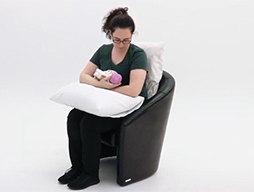Back and pelvic care after pregnancy
Recovering from pregnancy is already physically demanding without having to cope with pain.
Hip and pelvic pain can continue after your baby is born, so it is important to avoid tasks and activities that make these pains worse. Build up your activity levels slowly. Balancing rest and activity will help.
The following tips will help you care for your back and pelvis after pregnancy.
Lift as little as possible
- Do not lift anything heavier than your baby for 6 weeks after a caesarean or if you have sustained a third or fourth-degree perineal tear
- Avoid lifting heavy objects without assistance.
- Limit carrying the baby capsule. Leave it in the car and use the baby sling or pram instead.
- Use small nappy buckets and use a trolley to take washing out.
- Put fewer items in each shopping bag and make more trips.
- Ensure change tables and prams are at waist height.
Take care when lifting
- Bend your knees and get as close as possible to the object you are lifting.
- Straighten your legs as you lift.
- Tighten pelvic floor before lifting.
- Avoid twisting. Turn by moving your feet, not your back.
- Avoid holding your breath when lifting – keep breathing.
- Keep items you use often at convenient height.
Supported postures and changing positions regularly may help to reduce back pain.
Read more about maintaining good posture after pregnancy.
 Poor sitting posture can also contribute to back pain. Be sure to sit in a well-supported position and use a foot stool under your feet. Avoid sitting in bed if you have back pain.
Poor sitting posture can also contribute to back pain. Be sure to sit in a well-supported position and use a foot stool under your feet. Avoid sitting in bed if you have back pain.
It is also important to sit comfortably before feeding:
- Sit in a supportive and if possible, a high back chair. Make sure your back is supported against the backrest.
- Support your lower back with a cushion or rolled-up hand towel.
- Place a pillow under your baby to bring the baby closer to your breast or the bottle.
- Relax your shoulders.
Look down to ensure your baby attaches to the breast or bottle, then use this time to do gentle neck stretches and your pelvic floor exercises.
See how exercise can help manage and reduce back pain after pregnancy.
Tips to manage back pain after pregnancy
Stretches for back pain
The same back and pelvic stretches we recommend for during pregnancy are just as helpful after pregnancy.
Take care in the nursery
- Always lower the cot sides and position yourself close to the cot. Try lunging instead of bending over.
- Have the change table at waist height. If you need to change your baby on the bed, kneel on the floor next to the bed.
Take the strain out of bath-time
- Avoid carrying a heavy baby bath full of water – instead, fill and empty the bath using water jugs.
- Sit the bath on the change table/washing machine/laundry bench or something of waist height.
- When you use an ordinary bath, knee on the floor next to the bath so you don’t bend over.
More information
Find out more about physiotherapy after pregnancy, caring for you after birth, or return to the Maternity page.

